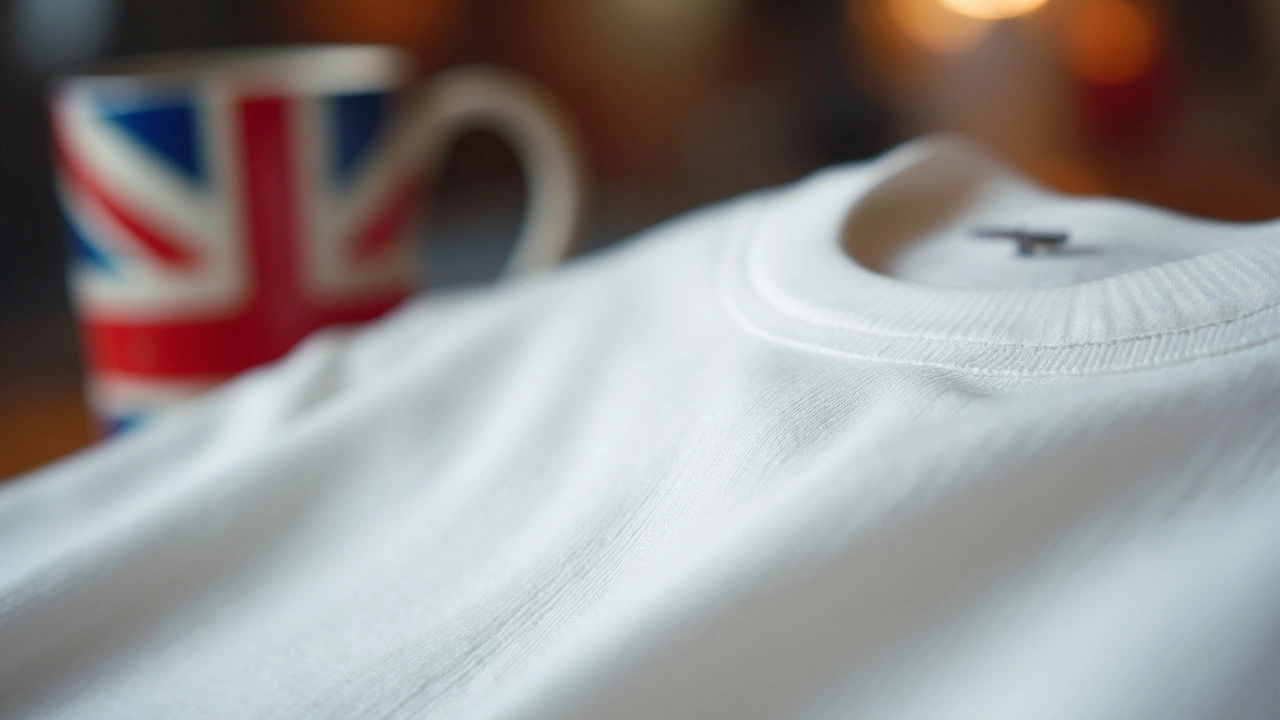Ever grabbed a t-shirt that looked nice on the rack but turned into a stretched-out mess after one wash? It's not just bad luck—it’s often because the shirt wasn’t made with lasting quality in mind. If you’re tired of tees that fade, pill, or lose their shape, it’s time to get picky.
The funny thing is, you don’t need a microscope to judge quality. Your hands and eyes are the best tools you’ve got. Some of the quickest signs show up before you even put the shirt on. You just need to know what to look for. Want to keep your t-shirts soft and looking new? Let's break down what really matters before you buy.
- Feel the Fabric
- Inspect the Stitching
- Check the Shape and Fit
- Label Truths: What Materials Matter
- Real-Life Stress Test
Feel the Fabric
The first thing you’ll notice about any t-shirt is how it feels in your hands. High-quality tees feel soft but not flimsy—they should have a bit of weight and feel smooth against your skin. Thin, rough, or see-through fabric is usually a sign of lower quality and won’t last long.
Most of the best t-shirts are made from 100% cotton, but there’s a huge difference between regular cotton and better options like Pima or Supima cotton. These types use longer fibers, so the shirt feels softer and lasts way longer. Polyester blends can make shirts cheaper and sometimes add stretch, but pure cotton wins for breathability and comfort.
Here's a quick way to judge fabric before you buy:
- Bunch up a corner of the shirt in your hand. Does it bounce back, or stay all wrinkled? Quality fabric snaps back.
- Hold the shirt up to the light. If you can clearly see your hand through it, the weave is probably too thin to last.
- Rub the fabric between your fingers. It should feel even, not scratchy or rough.
Ever wondered how fabric type affects durability? Check out this comparison:
| Fabric Type | Softness | Durability | Breathability |
|---|---|---|---|
| Pima/Supima Cotton | Very High | Very High | High |
| Regular Cotton | Medium | Medium | High |
| Polyester Blend | Medium | Medium | Medium |
| Cheap Synthetics | Low | Low | Low |
The high-quality t-shirt usually feels softer, heavier, and more solid than basic tees. Give yourself permission to touch every shirt before you buy—you’ll start to notice the difference pretty quickly!
Inspect the Stitching
This is where most cheap tees give themselves away. High-quality t-shirts aren’t just about nice fabric—they’re held together with solid, careful stitching. When factories cut corners, stitching is the first place you’ll see problems.
Flip your t-shirt inside out and check the seams. Good shirts have even, tight stitches with no loose threads hanging out. Double stitching (two rows of stitches) on sleeves and hems adds serious strength and helps the edges keep their shape, even after lots of wear and washing. Ever had a seam split? That’s usually because the stitching was lazy or missing extra reinforcement.
- Look for at least 7-10 stitches per inch (SPI). More stitches mean the fabric will stay together longer, especially at stress points like underarms and shoulders.
- If you see big, loose, or uneven stitches, it’s a red flag that corners were cut.
- Check for bar tacks—extra stitches at spots that take a lot of stress, like the ends of the sleeve seam. This signals the maker actually cared about strength.
A quick way to test: gently pull the seam apart. If you see gaps or light between stitches, or if the seam stretches way too easily, move on to the next t-shirt.
| Feature | Cheap T-Shirts | High-Quality T-Shirts |
|---|---|---|
| Stitch Count (SPI) | 4-6 | 7-10 |
| Loose Threads | Common | Rare |
| Double Stitching | Seldom | Usually Present |
| Bar Tacks | Missing | At Stress Points |
Stitching takes only a few seconds to check, but it makes a huge difference in how your high-quality t-shirt holds up. Paying attention to this saves money (and headaches) in the long run.

Check the Shape and Fit
High-quality t-shirts aren’t just about looks; the way they keep their shape over time tells you everything. A shirt that’s cut properly will sit right on your shoulders and skim your body—not cling, not billow. If it feels off the first time you wear it, that’s not going to change. Don’t trust a shirt to “break in.”
One quick test is to lay the shirt flat and fold it in half from shoulder to shoulder. Do the side seams line up? High-end t-shirts are cut symmetrically, with sleeves and sides matching up neatly. If the seams twist or the sleeves hang crooked, you’re looking at cheap work or bad materials.
Try another trick: gently tug on the hem or neckline and see how much it stretches. A good shirt will snap back instead of drooping. If the ribbing gets all wavy, keep looking.
- Look for a neckline that hugs your neck without choking you—it should stay that way after a few washes.
- Bodies and sleeves should be cut clean, not wildly loose or super tight unless it’s actually meant to be oversized.
- The shirt’s length matters, too. They shouldn’t end above your belt when you lift your arms.
Check out this comparison between high-quality and low-quality t-shirts after a few washes:
| Feature | High-Quality T-Shirt | Low-Quality T-Shirt |
|---|---|---|
| Shape after 10 washes | Keeps shape | Stretches or warps |
| Seams | Stay straight | Twist or bunch up |
| Fit | Consistent | Gets baggy or shrinks |
Remember, a high-quality t-shirt will make you look good every time you wear it, not just the first week. That’s worth checking before you pull out your wallet.
Label Truths: What Materials Matter
Ever flipped a t-shirt inside out and squinted at the tag? That tiny label tells the real story about what you’re buying. Materials completely change how a tee feels, lasts, and even washes up. Most people spot “100% cotton” and call it a day, but there’s more to it than that.
If you want a high-quality t-shirt, look for these types of fabric:
- Pima or Supima Cotton: These are like the gold standard of cotton—super soft, don’t pill as fast, and survive way more washes. Supima is just the American-grown version of Pima and is pretty easy to spot on tags.
- Combed Cotton: This goes through an extra brushing process so it feels smoother and lasts longer than basic cotton.
- Organic Cotton: Kinder on your skin and better for the planet, but look for certified organic labels (like GOTS) because “organic” can sometimes be all talk.
- Cotton-Poly Blends: Some blends are actually a good thing! Around 80/20 or 60/40 cotton/polyester makes shirts less likely to shrink or wrinkle, but too much polyester can feel stiff or trap odor.
- Linen or Modal: Not super common, but these materials are known for keeping things breezy and soft. Modal, for example, is made from beech trees and is seriously smooth to the touch.
Avoid tees with lots of “viscose” or “rayon” if you want them to hold up for years—they feel silky at first but can stretch out and get worn fast. Also, shirts with vague labels like “all new materials” or “fiber blend” are usually just cheap fillers and rarely last.
If you’re shopping online, most legit brands list these details right on the product page. No info? Take that as a red flag. And don’t forget: if a shirt feels too light or thin in person, it’s probably not made to last—the label might say cotton, but it’s usually low-grade stuff.

Real-Life Stress Test
Before you buy, it’s smart to put a t-shirt through some quick "stress tests" right in the store—or even at home, if you already own it. Most high-quality t-shirts handle these like champs. No fancy gadgets needed, just your hands and a few simple moves.
Here’s what you can try:
- Stretch Check: Grab the shirt by its hem and gently pull. Good tees snap back instead of staying loose or saggy. If you see the fabric staying stretched or warping, that’s a red flag.
- Light Test: Hold the shirt up to the light. Thin spots or uneven weave mean it might wear out faster. High-quality t-shirts usually look dense and even all over, not patchy or see-through.
- Pill Test: Rub a small area of fabric (like at the side seam) between your fingers for 15 seconds. If tiny balls (pills) start popping up, expect this to get worse in the wash. Durable shirts are less likely to pill, especially if the cotton is combed or ringspun.
- Pull on the Seams: Gently tug on a seam—like at the shoulder or the bottom hem. Seams on a quality shirt feel solid and look tidy, with no loose threads or gaps. Bad seams split easily or show uneven stitching.
- Twist Test: Twist the shirt a little at the body. If it doesn’t spring back or looks permanently wrinkled, it likely won’t last.
If you like numbers, here’s how the best t-shirts compare to the budget ones after a few months of regular wear and washes:
| Test | High-Quality T-Shirts | Cheap T-Shirts |
|---|---|---|
| Shape after washing (10+ cycles) | Retain shape | Often shrink or warp |
| Color fade (measured visually) | Minimal fading | Noticeable fading |
| Pilling | Rare/minimal | Frequent |
| Seam durability | Intact seams | Loose or splitting seams |
One more tip—don’t be shy about asking the store staff what they know about the shirt’s construction. Sometimes they’ll even let you know whether it’s pre-shrunk or enzyme washed for extra softness. The more you stress test, the less likely you’ll end up with a shirt that falls apart, no matter how good it looked on the hanger. It’s the easiest way to make sure you’re really getting a high-quality t-shirt.

